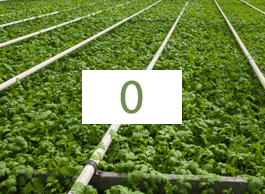
In the time it takes you to read this sentence, 169 new tree seedlings will have been planted somewhere in a commercial forest in Canada. By the time you get to the bottom of the page that number will have jumped to over 2500. On average, more than a thousand seedlings are launched on a new life every minute, regenerating what Canada has plenty of — forests. The latest annual harvest for timber and pulp and paper amounted to less than 0.2% of what’s out there[1].

Average number of new seedlings planted per minute
Forest companies regenerate the forest they use because of self-interest (they want it to be there when they need it in future), but also because over 90% of Canada’s commercial forests are located on crown land, owned by the provinces. By law, these companies must meet provincially-set sustainability levels. At the moment, timber is being harvested at rates 30% below what’s considered to be the sustainable limit for Canada’s wood supply[2]. The Canadian forest industry is also a world leader in both independent third-party certification of forests and chain-of-custody certification (responsible sourcing of its raw materials)[3]. This environmental indicator is endorsed by the global alliance of retailers and consumer goods companies, The Consumer Goods Forum[4].
What’s this got to do with paper packaging? Canada’s paper packagers are by no means the major “consumers” of the forest (bugs and insects chomp their way through 14 times as much as the whole lumber and pulp and paper industries combined, forest fires almost four times as much)[5]. And, in fact, most of the boxes and cartons manufactured in Canada are made from 100% recycled fibre collected from the back of factories and supermarkets, or from curbside. But public perception always seems to come back to the tree, and to our collective stewardship of it. We don’t have a problem with this, because we can prove that Canada’s forest industry has done, and is doing, a pretty good job.
It does make us wonder, though, why more attention is not being paid by our customers and governments to the stewardship of the non-renewable resources used by our packaging competitors, who don’t seem to have any qualms about throwing mud at us, an industry that’s founded on resources that are actually renewable. Where are their independent third-party certifications of the resources they use? Where are their chain-of-custody certifications?
The major retailers and consumer packaged goods companies are loud advocates of the principle of a level playing field between themselves and between importers of packaging when it comes to extended producer responsibility or EPR schemes; and are adept at arguing for the principle of a level playing field (no cross-subsidisation in the funding fee formulas) between packaging materials. Many of these same level playing field advocates have endorsed and insisted that their paper suppliers meet independent third-party forest certification and chain-of-custody standards.
So where’s their action (not words) on developing similar independent third-party certification and chain-of-custody requirements for the extraction of non-renewable oil and natural gas deposits, for example? Don’t we have a right to a level playing field too?
___________________________________________________________________________________________________________
[1] Planting of tree seedlings per minute derived from over 500 million planted per year; Canada’s harvest area (0.2%) from The State of Canada’s Forests, Annual Report 2013, Natural Resources Canada, pages 11 and 19.
[2] Ibid., page 11
[3] Ibid., page 4. Some 38% of the world’s total certified forests are in Canada. Also see PPEC press release on its members’ Chain-of-Custody certification here.
[4] Consumer Goods Forum, Global Protocol on Packaging Sustainability.
[5] The State of Canada’s Forests, ibid., page 45. Harvest area 0.6 million hectares; Fire burned 1.9 million hectares: Defoliated by insects and beetle-killed trees 9.2 million hectares.
